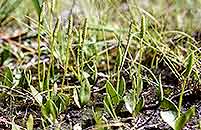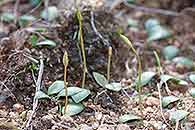Ophioglossum rubellum Welw. ex A.Braun
Synonyms |
|
|---|---|
Common name |
|
Description |
Rhizome pear-shaped to rounded or narrowly oval, (1.5-)3-11(-19) × 1-5 mm; roots dense, descending, wiry, proliferous. Leaves mostly 2 (1-3), held at 20° from the horizontal or appressed to the ground, dark green often with a reddish to orange coloration. Stipe up to 2 cm long, subterranean for most of its length (75-90%), stipe:lamina lenght ratio 1.7-1.2:1. Sterile lamina up to 17 × 10 mm, elliptic to broadly ovate in outline, apex pointed to sometimes rounded, base wedge-shaped to truncate, with an apparent pale pseudo-midrib formed towards the base of the lamina only. Fertile segment up to 7.2(-9.3) cm long, inserted at the base of the lamina, fertile spike:lamina lenght ratio 2.1-5.6:1. Sporangia 3-17 pairs, apex pointed. |
Notes | Could be mistaken for O. costatum which usually has dull green leaves that are held at 60-80° of the ground and a prominent pale pseudo-midrib. O. convexum has linear dull green leaves held at 0-30% from the horizontal, the pale pseudo-midrib is absent. |
Derivation | rubellum: reddish; referring to the reddish to orange coloration present in the leaves. |
Habitat | Seasonally moist sandy soils overlying granite or sandstone in mixed deciduous woodland. |
Distribution worldwide | See African distribution. |
Distribution in Africa |
Angola, Benin, Central African Republic, Ethiopia, Gabon, Ghana, Kenya, Malawi, Sierra Leone, South Africa, Tanzania , Uganda, Zambia, Zimbabwe. |
Growth form |
Terrestrial. |
Literature |
|


